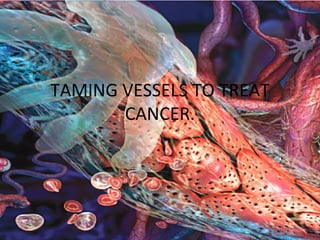Report
Share

Recommended
Recommended
Primary mediastinal liposarcoma of the superior, middle, and anterior mediast...

Primary mediastinal liposarcoma of the superior, middle, and anterior mediast...Mary Ondinee Manalo Igot
More Related Content
What's hot
Primary mediastinal liposarcoma of the superior, middle, and anterior mediast...

Primary mediastinal liposarcoma of the superior, middle, and anterior mediast...Mary Ondinee Manalo Igot
What's hot (20)
modern diagnostic and treatment methods of 21 senture in children oncohematol...

modern diagnostic and treatment methods of 21 senture in children oncohematol...
Primary mediastinal liposarcoma of the superior, middle, and anterior mediast...

Primary mediastinal liposarcoma of the superior, middle, and anterior mediast...
Neurologic Complications of Hematologic Malignancies 

Neurologic Complications of Hematologic Malignancies
Kidney Cancer and Chronic Kidney Disease: A Causal Link by Wanda Reese

Kidney Cancer and Chronic Kidney Disease: A Causal Link by Wanda Reese
Viewers also liked
Viewers also liked (12)
Four turn wheel structure powerpoint diagrame templates 0712

Four turn wheel structure powerpoint diagrame templates 0712
SCIENTISTS IDENTIFY MOLECULAR BASIS FOR DNA BREAKAGE, A HALLMARK OF CANCER CE...

SCIENTISTS IDENTIFY MOLECULAR BASIS FOR DNA BREAKAGE, A HALLMARK OF CANCER CE...
Wheel diagram ppt slides presentation diagrams templates

Wheel diagram ppt slides presentation diagrams templates
5 parts circle diagram ppt slides presentation diagrams templates

5 parts circle diagram ppt slides presentation diagrams templates
3 d interconnected circular puzzle pieces 5 stages powerpoint diagrams and p...

3 d interconnected circular puzzle pieces 5 stages powerpoint diagrams and p...
3d circular puzzles 5 stages powerpoint presentation templates

3d circular puzzles 5 stages powerpoint presentation templates
Flipped Classroom-Full Picture Presentation - 2013

Flipped Classroom-Full Picture Presentation - 2013
Similar to Taming Vessels
Similar to Taming Vessels (20)
Dissertation topics on cellular basics of cancer and therapeutics - Pubrica

Dissertation topics on cellular basics of cancer and therapeutics - Pubrica
Integrative Cancer - New theories and Advances in Treatment From Hippocrates ...

Integrative Cancer - New theories and Advances in Treatment From Hippocrates ...
More from hiratufail
More from hiratufail (20)
Recently uploaded
Escort Service Call Girls In Sarita Vihar,, 99530°56974 Delhi NCR

Escort Service Call Girls In Sarita Vihar,, 99530°56974 Delhi NCR9953056974 Low Rate Call Girls In Saket, Delhi NCR
Recently uploaded (20)
Sonagachi Call Girls Services 9907093804 @24x7 High Class Babes Here Call Now

Sonagachi Call Girls Services 9907093804 @24x7 High Class Babes Here Call Now
VIP Call Girls Pune Vrinda 9907093804 Short 1500 Night 6000 Best call girls S...

VIP Call Girls Pune Vrinda 9907093804 Short 1500 Night 6000 Best call girls S...
College Call Girls Vyasarpadi Whatsapp 7001305949 Independent Escort Service

College Call Girls Vyasarpadi Whatsapp 7001305949 Independent Escort Service
Call Girls Hosur Just Call 7001305949 Top Class Call Girl Service Available

Call Girls Hosur Just Call 7001305949 Top Class Call Girl Service Available
Call Girls Service In Shyam Nagar Whatsapp 8445551418 Independent Escort Service

Call Girls Service In Shyam Nagar Whatsapp 8445551418 Independent Escort Service
Housewife Call Girls Bangalore - Call 7001305949 Rs-3500 with A/C Room Cash o...

Housewife Call Girls Bangalore - Call 7001305949 Rs-3500 with A/C Room Cash o...
Call Girls In Andheri East Call 9920874524 Book Hot And Sexy Girls

Call Girls In Andheri East Call 9920874524 Book Hot And Sexy Girls
Russian Call Girl Brookfield - 7001305949 Escorts Service 50% Off with Cash O...

Russian Call Girl Brookfield - 7001305949 Escorts Service 50% Off with Cash O...
Book Call Girls in Yelahanka - For 7001305949 Cheap & Best with original Photos

Book Call Girls in Yelahanka - For 7001305949 Cheap & Best with original Photos
Call Girls ITPL Just Call 7001305949 Top Class Call Girl Service Available

Call Girls ITPL Just Call 7001305949 Top Class Call Girl Service Available
Call Girl Service Bidadi - For 7001305949 Cheap & Best with original Photos

Call Girl Service Bidadi - For 7001305949 Cheap & Best with original Photos
Low Rate Call Girls Mumbai Suman 9910780858 Independent Escort Service Mumbai

Low Rate Call Girls Mumbai Suman 9910780858 Independent Escort Service Mumbai
Call Girl Lucknow Mallika 7001305949 Independent Escort Service Lucknow

Call Girl Lucknow Mallika 7001305949 Independent Escort Service Lucknow
Escort Service Call Girls In Sarita Vihar,, 99530°56974 Delhi NCR

Escort Service Call Girls In Sarita Vihar,, 99530°56974 Delhi NCR
Call Girls Hebbal Just Call 7001305949 Top Class Call Girl Service Available

Call Girls Hebbal Just Call 7001305949 Top Class Call Girl Service Available
Call Girls Thane Just Call 9910780858 Get High Class Call Girls Service

Call Girls Thane Just Call 9910780858 Get High Class Call Girls Service
Call Girls Service in Bommanahalli - 7001305949 with real photos and phone nu...

Call Girls Service in Bommanahalli - 7001305949 with real photos and phone nu...
Russian Call Girls in Pune Riya 9907093804 Short 1500 Night 6000 Best call gi...

Russian Call Girls in Pune Riya 9907093804 Short 1500 Night 6000 Best call gi...
Taming Vessels
- 1. TAMING VESSELS TO TREAT CANCER.
- 8. Radiotherapy
